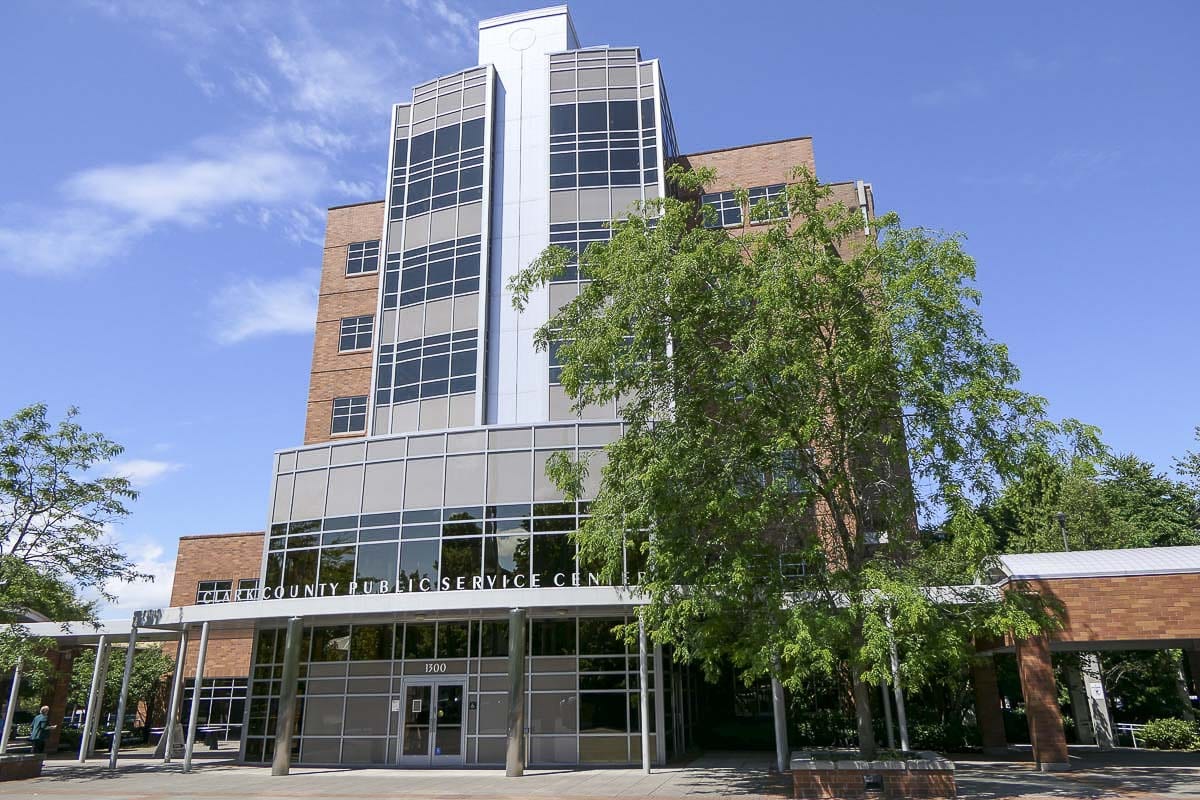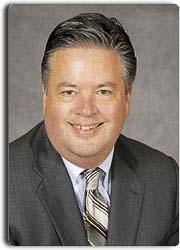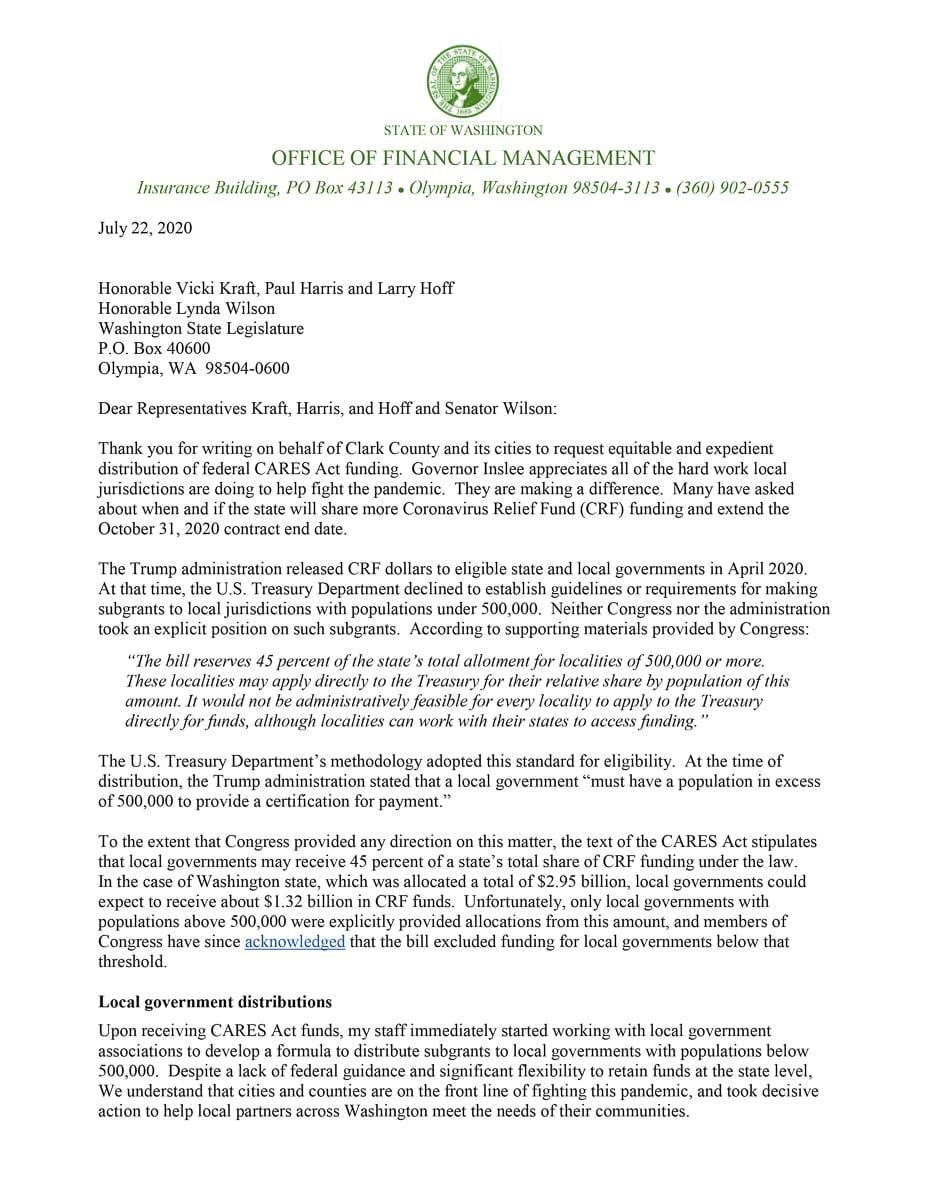Clark County officials say the concession is still far less than what the state was required to disperse as part of the CARES Act funding package
CLARK COUNTY — A month and a half after Clark County councilors penned a letter to Washington Gov. Jay Inslee, urging him to release their full allotment of CARES Act funding, the state has responded.
But the answer seems to have left county officials even more frustrated and confused.

Clark County was among the first local governments in the state to point out that the $290 million the state allotted for local governments from the $2.2 billion it received as part of the Coronavirus Relief Fund (CRF) under the CARES Act, was less than a third of what larger cities and counties had received.
The US Department of Treasury (DOT) directly apportioned funding from the CRF to any city or county with a population larger than 500,000 people. That amounted to $800 million in Washington state, including $91.2 million for Spokane County, with a population of 523,000.
Clark County, by comparison, received $26.8 million from the state, despite having a population just 7.4 percent smaller than Spokane County.
Several state legislators from Southwest Washington later signed onto a letter from Rep. Vicki Kraft, also urging the governor and the Office of Financial Management (OFM) to look into the situation.
On July 2, three weeks after the county sent their initial letter, the governor’s office reached out to Clark County Today, promising that updated guidelines for distributing the CRF money would be coming within the next week.

After repeated delays, on Wednesday night OFM Director David Schumacher sent a letter to the Southwest Washington delegation, along with lawmakers and elected officials from Kitsap County, Mason County, and the Washington State Associations of Cities and Counties, providing more details and an updated timeline for CARES Act funding distributions.
Schumacher committed to freeing up an additional $247 million in funding for local governments — without detailing how the money would be allocated — and said they were willing to be flexible in regards to the current reimbursement application deadline of Oct. 31.
In his letter, Schumacher maintains that OFM has done the best it can, despite a lack of guidance from Congress or the White House.

“Upon receiving CARES Act funds, my staff immediately started working with local government associations to develop a formula to distribute subgrants to local governments with populations below 500,000,” the letter reads. “Despite a lack of federal guidance and significant flexibility to retain funds at the state level, We understand that cities and counties are on the front line of fighting this pandemic, and took decisive action to help local partners across Washington meet the needs of their communities.”
To back that up, Schumacher cites the following as the only guidance from Congress on how states should distribute the funding.
“The bill reserves 45 percent of the state’s total allotment for localities of 500,000 or more. These localities may apply directly to the Treasury for their relative share by population of this amount. It would not be administratively feasible for every locality to apply to the Treasury directly for funds, although localities can work with their states to access funding.”
Clark County Finance Director Mark Gassaway sees it much differently.
“The true part of this statement is OFM wants to retain funds at the state level,” Gassaway wrote in an email after Clark County Today showed him Schumacher’s letter. “The Department of Treasury has given clear guidance and a formula on how CARES ACT funding should be distributed.”
To prove his point, Gassaway refers to a DOT document, last updated July 8, responding to frequently asked questions.
It reads, in part:
“Consistent with the needs of all local governments for funding to address the public health emergency, states should transfer funds to local governments with populations of 500,000 or less, using as a benchmark the per capita allocation formula that governs payments to larger local governments.”
Then Gassaway highlights the final sentence in that paragraph.
“For example, a State received the minimum $1.25 billion allocation and had one county with a population over 500,000 that received $250 million directly. The State should distribute 45 percent of the $1 billion it received, or $450 million, to local governments within the State with a population of 500,000 or less.”
“OFM has created convenient math to justify their actions to retain funds at the state level,” Gassaway concluded, “however, it does not follow any existing guidance and does not create equity among local governments of all sizes.”
In short, the state maintains that it has the right to 55 percent of the total $2.95 billion sent by Congress, rather than 55 percent of what was left after larger governments received their share.
“Unfortunately, only local governments with populations above 500,000 were explicitly provided allocations from this amount,” Schumacher wrote, “and members of Congress have since acknowledged that the bill excluded funding for local governments below that threshold.”
Even if that were the case, Gassaway pointed out, it wouldn’t explain why the state decided to only distribute $290 million initially.
Schumacher doesn’t detail that decision, but notes that “the state, in consultation with the Legislature, also agreed to hold an additional $240 million for local governments to address future needs and emerging problems.”
Clark County Councilor Gary Medvigy said he has been in frequent contact with state legislators from the area, and none of them were aware of any such agreement.

Schumacher did not respond to a request for clarification on Thursday, and OFM employees are on unpaid furlough most Fridays through the Summer due to budget reductions.
Medvigy has been amongst the most vocal critics of the state’s handling of financial assistance to local governments, and says the state’s reluctance to follow DOT guidance, and the slow response to their inquiries, has left them in a financial bind.
“We have limited capability and we’ve got more than other counties to actually budget,” Medvigy told Clark County Today. “And every day that goes by eliminates the ability to budget for that greater amount.”
Despite admitting in his letter that “cities and counties are on the front line of fighting this pandemic,” Schumacher also seems to indicate that they are best served by the state holding onto the money and doling it out as needed.
“The state has continued to work with local governments and state agencies to make additional investments as needed,” Schumacher writes. “For example, additional funds are going to the Yakima Health District to help battle the outbreak in that county, and millions of dollars’ worth of personal protective equipment has been provided to local jurisdictions for free.”
Medvigy says he reads Schumacher’s comments as a “lack of trust in local governments.”
“We know how to spend it, and it should be spent locally where the need is,” he said. “For them to hold back that amount of money should be a concern of every citizen.”
Both Medvigy and Gassaway also expressed their frustration with Schumacher’s assessment that “as of July 1, 2020, no jurisdiction that is party to a signed contract with the state has exhausted its share of the nearly $300 million distribution in population-based grants.”
“We are required to submit reimbursement which means the County pays the upfront cost creating cash flow concerns,” wrote Gassaway. “Public Health alone will consume over $10M with cost escalating daily.”
Gassaway said his department has already budgeted for the entire $26.8 million, though the money has to be spent before they apply to have the state reimburse them.
“We have to budget for what we’re allocated,” Medvigy added. “So we budgeted to what they allocated us, as I’m sure every other county did. If we were budgeted for what we were owed we would have a spending plan in place.”
While noting that OFM is willing to work with local governments when it comes to the existing Oct. 31 date to apply for reimbursement, Schumacher concludes “the Legislature and I want to make sure all of the $2.95 billion is expended by December 31, 2020.”
And that, say Gassaway and Medvigy, underlines the entire conversation about how the state is handling this money.
It all must be spent by the end of December. Whatever isn’t spent goes back to the federal government.
Medvigy says he believes the state has plans for the money, and is intentionally making it difficult for local governments to use it, in order to use it to cover their own expenses after October.
“I’m unhappy that we have no specifics yet,” concluded Medvigy. “And we know where to spend the money, if we will just be granted what was intended by our Treasury Department and Congress.”




